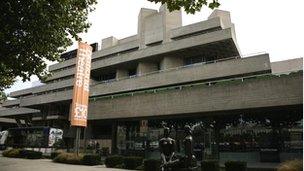Why small is now big in theatreland
- Published

The National Theatre in London is about to unveil its new temporary stage, The Shed. It will fill the gap until the National re-opens its revamped, renamed third auditorium next year.
The Shed's audience capacity is around a fifth of that of the National's biggest stage and the theatre hopes to bring in new audiences. So have modern theatregoers developed a taste for the small and impermanent?
Iain Mackintosh recalls his reaction when he was drafted in to salvage plans for a third National Theatre auditorium in the 1970s, worryingly close to the building's scheduled opening date.
"The overall architect was Denys Lasdun, but a couple of years earlier he'd been told to cancel the third space, the Cottesloe, to save money.
"But that space sat beneath the stage of the Olivier Theatre - not wholly by chance - so it couldn't be lopped off and discarded which is what the civil servants wanted.
"When I walked in, it was an empty rectangular concrete shell. I remember thinking it would be perfect to tether a Zeppelin in."
At the last moment cash had been found to revive plans for a small third auditorium, and Mackintosh had the job of fitting it out while Lasdun got on with the main building.
The original plan had been for an audience capacity of fewer than 250, but the studio theatre ended up with around 400 seats.
As a result, visiting the Cottesloe often proved a squeeze.
"It was always clear there'd be far too little space for 400 people to move around in," says Mackintosh. "Nowhere to eat, the lobby tiny, not enough loos - not enough anything.
"From next year the Dorfman" - the new name for the Cottesloe - "will be better for audiences. But they're not changing the actual theatre very much, I'm glad to say: it's proved a size of auditorium which modern audiences enjoy."
It's indicative of contemporary taste that with The Shed, the National is for the next year scaling down to 225 seats. (In contrast, the NT's Olivier stage has 1,100 seats while the Lyttelton has 890.)
Steve Tompkins of Haworth Tompkins architects is in charge of the project. He says its relative smallness and the fact it's not a permanent building aren't problems and will attract the young audiences whose tastes are changing theatre.
"Audiences have become less impressed by the grandiose and are more at home with the intimate, informal and pop-up. There's a new sort of energy you get at festivals and other events which theatre needs to tap into.
"Twenty years ago audiences might have resented walking into a building which was clearly temporary; now it's just the opposite. Maybe it's the influence of the internet: nothing is static and nothing is permanent."
According to Tompkins, Sir Nicholas Hytner - the National Theatre's artistic director - "had one key instruction - that what happens in The Shed has to feed back eventually into the rest of the building.
"That's why we're doing it next to the existing theatre, and not on a separate site somewhere.
"Some of the work will be more left-field than what the National has offered until now. Though in other ways The Shed is pretty traditional: the playing area is basically the eight-metre cube which we know is perfect for the human form.
"We've given The Shed a patina of rusty steel and plywood; it's not supposed to have a shiny, corporate feel. And it's good we had to build quickly - just as Iain Mackintosh did with the Cottesloe in the '70s.
"Sometimes when you design a theatre it becomes a five or six-year project: energy-levels drop and focus is lost. But I think The Shed reflects our light-footed approach and audiences will pick up on that."
The trend toward the pop-up has been influenced by the likes of Punchdrunk, the British company which stages productions such as Sleep No More.
The show, a noir thriller, is currently playing in New York in a space masquerading as 'The McKittrick Hotel'.
One of the smaller companies to have learnt from Punchdrunk is Defibrillator. Its artistic director, James Hillier, has just staged three short Tennessee Williams plays, set in hotels, in a hotel in central London.
"We staged each play on a different floor, and you could see people were really stimulated by moving around the building," he says.
"We had a fair number of conventional theatregoers but we also got lots of what I call 'Cultural Nomads'. These are people who are interested in theatre, but they're equally interested in music and clubbing and cinema.
"Their reasons for going to a particular show aren't the same as someone who goes to everything at the Old Vic or the Donmar [Warehouse]. They love the adventure and glamour of the unconventional and new.
"I noticed a definite overlap with audiences who go to things like Secret Cinema - people who love the sense of event. People told us they'd enjoyed the fact the Hotel Plays were in an unusual location and for a limited time; audiences actually seemed to revel in the impermanence.
"The fact they might have been sitting on a hard hotel chair for half an hour didn't really matter as long as the setting intrigued them.
"So now we're talking to representatives of writers like Arthur Miller and Caryl Churchill about doing their work in unusual settings.
"People are keen. I think everyone realises there's a new kind of audience developing out there. "
The first public performance in The Shed will take place on 9 April.
- Published30 January 2013
- Published28 October 2010